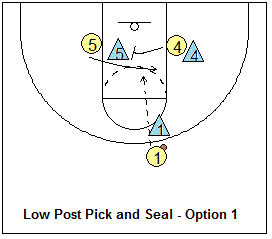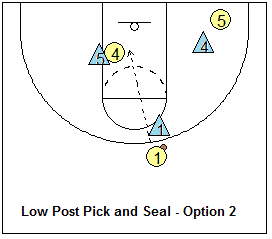Basketball Plays - 3-on-3 Plays
From the Coach’s Clipboard Basketball Playbook"Helping coaches coach better..."
See more comments...

There are a lot of 3-on-3 tournaments out there that you can get into. Although, generally I'm not a great fan of these events (no refs, street ball, injuries, lack of sportsmanship, etc), you can use these events to perfect your motion offense screen, seal and roll plays. Then when basketball season starts, these simple plays will be a part of your team game and "second nature".
In 3-on-3 tournaments, play with teammates from your school team... players whose abilities (strengths and weaknesses) you are already know and whom you will be playing with next season. Learn to play together and "read" what each other is doing. Have fun and remember your sportsmanship. These battles sometimes become heated and very personal... don't lose your cool.
Strong defense and rebounding will win many of these games. Outside shooting is difficult on windy days outdoors, or when looking into a bright sun... get the ball inside.
Parents... let the kids play. Nowadays I see parents coaching 3-on-3 teams! I think this is not a good trend. Kids today have almost all their play-time structured by parents and coaches. When I was a kid (long ago!), we would just get a bunch of kids together, choose up sides and play. We worked out any close calls or differences of opinion on our own.Kids need to learn these skills in dealing with other kids and how to work things out. I believe they really don't need parents yelling at them, or the other team, or (if there is one) the ref. Let them coach themselves and see what they can come up with on their own... you might be surprised! These events should just be fun things... not the world championships.
Having said all that, here are some simple, but very effective plays if run correctly. First learn how to set a good screen and how to seal the person you screened, and then roll to the open spot for the pass. Read this page on the proper way to set screens.
These plays are all part of any motion offense that your school team might want to use, and you will find many of these same plays on my motion options and motion offense drills pages.
The secret to all of these screen plays is this. Realize that the person setting the screen will often be the person receiving the pass for the shot. So if you set a screen correctly, you may actually be setting yourself up for an easy shot. After you set the screen, "seal" (box-out) the person you are screening, so that you get inside position on him/her.
Then when your teammate cuts around the screen, he/she could be open for the shot, but chances are the defense will "switch" and your defender will go with the cutter. Now if you have sealed (boxed-out) correctly, you can step toward the hoop for the pass and shot. The other important element is the cutter must "clear out" if he/she doesn't receive the pass, so you maintain spacing.
Give and Go
The give and go involves a V-cut by O2 to receive the pass. O1 makes a fake step left and then a quick lane cut for the pass and lay-up.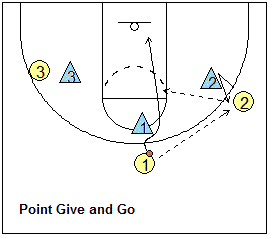
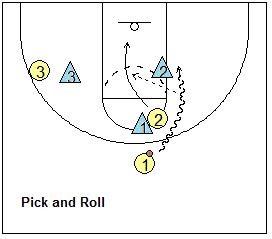
Pick and Roll
O2 sets an "on-ball" screen for O1. The pick 'n roll works if O2 seals the X1 defender correctly.Screen Away
O2 makes a V-cut to receive the pass from O1. O1 passes to O2, and "screens away" for O3 on the opposite wing. O3 rubs off the screen and cuts to the hoop.Make sure that O3 waits for the screen to arrive, and that O1 sets the correct angle on the screen.
Also, make sure that O1 seals the X3 defender, and then rolls to the hoop after O3 cuts around the screen (Diagram B). O2 can pass to either cutter.
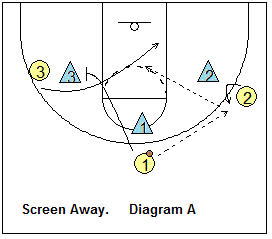
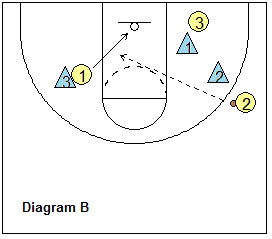
Down-screen Curl and Pin
O2 sets a down-screen for O3. O3 curls around the screen for the pass and shot.O2 pins (seals) the X3 defender and gets inside position. If the defense switches, then O2 should be open for the pass, assuming O3 clears out to the opposite side. Work this on both sides of the court.
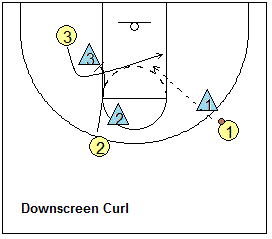
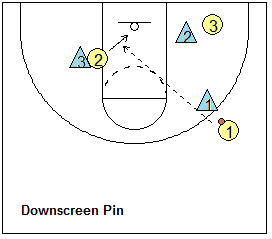
Back-screen and Pin
O5 (low post) comes up and sets a back-screen for the wing (O3). The wing cuts backdoor around the screen to the hoop for the pass and shot.O5 who has screened the X3 defender, "pins" the defender and gets inside position. If the defense switches, O5 should be open after releasing to the hoop for the pass and lay-up, assuming that O3 clears out to the opposite side.
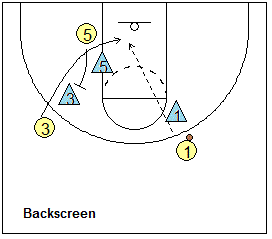
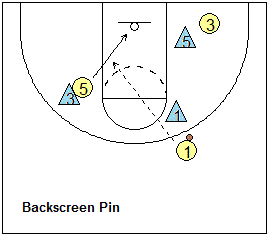
Feed the Low Post, Defender Behind
The wing player should to try to make the pass to the low post when the defender is playing behind. Once the pass is made, the opposite post should move to the high post, to allow spacing for O4 to make the post move on the defender. O2 can cut to the corner for the "inside-out" pass and shot.Defender Fronting the Low Post
O5 has to recognize this situation, and then flash to the ball-side high post position to receive the pass from O1. O4 should "pin", or seal, X4 defender and get inside position for the bounce pass (or high lob) from O5. The passing must be quick from O2 to O5 to O4.The other option here is having O4 pin the defender and "step-off" toward the hoop for the high lob pass directly from O2 to O4.
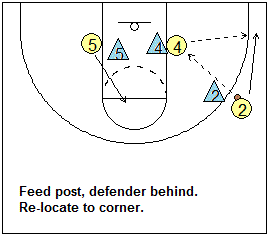
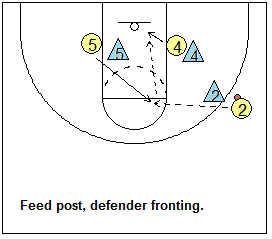
Double Low Post Pick and Seal
Use two post players working together, reading the defense, and screening for each other. O4 sets a screen for O5, who cuts around the screen for the pass and shot (option 1).O4 seals the X5 defender. If the defense switches and O5 does not receive the pass, then O4 should be open with inside position. (option 2).
